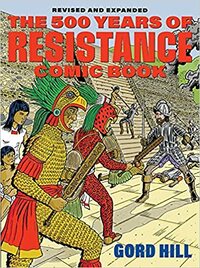You need to sign in or sign up before continuing.
Take a photo of a barcode or cover
45 reviews for:
The 500 Years of Indigenous Resistance Comic Book: Revised and Expanded
Gord Hill, Pamela Palmater
45 reviews for:
The 500 Years of Indigenous Resistance Comic Book: Revised and Expanded
Gord Hill, Pamela Palmater
adventurous
dark
informative
tense
medium-paced
Good. A good introduction to the major events of colonization and colonization resistance in the Americas. I was a bit more excited at the beginning because I could see how it wasn’t just telling the colonizer story. For example, it is pretty cool how hard the book goes on Colombus and how much he sucked. However, as I went on, I thought that the book could have been harder on the colonizers and added some more explanations that would help readers understand the atrocities taking place. I think sometimes because there wasn’t space to go into the details, an uncritical mind could interpret the indigenous resistance as too violent (and perhaps start to sympathize with the colonizers). Also some spots got really specific with how many people died and how many were wounded. With such little word count available, were the numbers of deaths the most important part? If so, then I think having little statements here and there about why the number of deaths is important to know would be good.
informative
medium-paced
I really appreciated the original, so I was excited to pick this one up. This revised and expanded version includes additional stories from 2010 up to the present day, and it’s also in colour! The 2010 version is black and white and has a sort of zine aesthetic, which is great, but this is an over-sized full colour version that is really striking. The illustrations are detailed and eye-catching, with rich colours.
This is a graphic history book describing the colonization of the Americas and Indigenous resistance to it. Obviously, 500 years of resistance to colonization over two continents is a lot to cover, so each section is pretty short, from a page to a handful of pages. It gives you the outline of some of the biggest conflicts in different areas, which will hopefully inspire readers to explore it in more depth.
Together, though, they form a narrative that is desperately needed, especially in a school setting. Even when colonialism is taught about or discussed in non-Indigenous spaces, it tends to frame Indigenous people as objects being acted upon: A list of terrible things that happened to Indigenous people. These comics give back agency, showing that Indigenous people have been resisting for hundreds of years and continue to, whether through warfare, protests, occupations of lands, or political strategizing.
Also, by being in a colourful comic format, it makes the information much more accessible than a dense history book. I would recommend not reading this book in one or two sittings, like I did. Because the comics have to condense a ton of information, it can be a lot to take in at once, especially with all the names and places mentioned. More importantly, this does not shy away from the brutal tactics of genocide, and reading about all of them back to back can be overwhelming. Do go in aware of that, and that it discusses murder, rape, torture, and other disturbing content.
Despite having read a fair bit about colonization of the Americas at this point in my life, every book--especially those by Indigenous authors--shocks me in the new depths and horrors of initial colonization as well as recent colonial tactics. But it also describes the rich cultures and civilizations of Indigenous peoples across the Americas, and it discusses the many victories, even if small or temporary, that get erased in more simplified tellings.
It is also packed full of interesting information in general, like I learned that in the Mayan city of Romina, they had a string of terrible male leaders succeeded by Lady K’awali. After her reign, they began a matrilineal system of descent, because apparently she was such a successful leader that they decided to switch strategies and stick with women from now on.
Also, I am mad that I am just now learning about Ganienkeh, a territory that was successfully reclaimed by Mohawk people and is to this day an independent sovereign territory. They are a dry community and have a school, lumber mill, golf course, and bingo hall. It’s not a reservation, it operates outside of US or Canadian control, and it was a result of them occupying their own unceded land.
The recent additions from 2010 onwards are especially inspiring, and it’s well worth picking up this new version even if you read the older one. It shows a growing coalition and network of support, especially across Canada, which has mobilized huge acts of resistance and solidarity. I think if you’re living on occupied land, it’s your responsibility to at the very least know its history, and this is a great place to start or supplement your education.
This is a graphic history book describing the colonization of the Americas and Indigenous resistance to it. Obviously, 500 years of resistance to colonization over two continents is a lot to cover, so each section is pretty short, from a page to a handful of pages. It gives you the outline of some of the biggest conflicts in different areas, which will hopefully inspire readers to explore it in more depth.
Together, though, they form a narrative that is desperately needed, especially in a school setting. Even when colonialism is taught about or discussed in non-Indigenous spaces, it tends to frame Indigenous people as objects being acted upon: A list of terrible things that happened to Indigenous people. These comics give back agency, showing that Indigenous people have been resisting for hundreds of years and continue to, whether through warfare, protests, occupations of lands, or political strategizing.
Also, by being in a colourful comic format, it makes the information much more accessible than a dense history book. I would recommend not reading this book in one or two sittings, like I did. Because the comics have to condense a ton of information, it can be a lot to take in at once, especially with all the names and places mentioned. More importantly, this does not shy away from the brutal tactics of genocide, and reading about all of them back to back can be overwhelming. Do go in aware of that, and that it discusses murder, rape, torture, and other disturbing content.
Despite having read a fair bit about colonization of the Americas at this point in my life, every book--especially those by Indigenous authors--shocks me in the new depths and horrors of initial colonization as well as recent colonial tactics. But it also describes the rich cultures and civilizations of Indigenous peoples across the Americas, and it discusses the many victories, even if small or temporary, that get erased in more simplified tellings.
It is also packed full of interesting information in general, like I learned that in the Mayan city of Romina, they had a string of terrible male leaders succeeded by Lady K’awali. After her reign, they began a matrilineal system of descent, because apparently she was such a successful leader that they decided to switch strategies and stick with women from now on.
Also, I am mad that I am just now learning about Ganienkeh, a territory that was successfully reclaimed by Mohawk people and is to this day an independent sovereign territory. They are a dry community and have a school, lumber mill, golf course, and bingo hall. It’s not a reservation, it operates outside of US or Canadian control, and it was a result of them occupying their own unceded land.
The recent additions from 2010 onwards are especially inspiring, and it’s well worth picking up this new version even if you read the older one. It shows a growing coalition and network of support, especially across Canada, which has mobilized huge acts of resistance and solidarity. I think if you’re living on occupied land, it’s your responsibility to at the very least know its history, and this is a great place to start or supplement your education.
Much like the original, this is an extended timeline of dates and facts illustrated by Gord Hill. It’s a great resource for seeing the constancy of Indigenous resistance to colonialism, Capitalism and white supremacy.
challenging
informative
reflective
medium-paced
Recounting 500 years of Indigenous and Tribal resistance in the Americas, Hill covers broad resistance from the Mapuche of Chile to the Potawatomi of the Maumee River basin to the Apache, Comanche, and northern Plains Tribal resistance, to the unceded territories of the Pacific Northwest, and everything in between.
Whether you are familiar with histories of Indigenous resistance in the Americas or not, you’ll undoubtedly learn something new. While selective (going for themes, not deep details, here) in coverage, the reader leaves with a deeper understanding of the history AND continuity of Indigenous resistance and the record of colonial forces over hundreds of years with the intention of erasing and eradicating these First Nations peoples across the Americas.
Whether you are familiar with histories of Indigenous resistance in the Americas or not, you’ll undoubtedly learn something new. While selective (going for themes, not deep details, here) in coverage, the reader leaves with a deeper understanding of the history AND continuity of Indigenous resistance and the record of colonial forces over hundreds of years with the intention of erasing and eradicating these First Nations peoples across the Americas.
Graphic: Genocide, Violence, Xenophobia, Colonisation
Moderate: Racism, Torture, Police brutality, Murder, War, Pandemic/Epidemic
Minor: Sexual assault, Sexual violence, Slavery, Suicide
dark
informative
reflective
sad
fast-paced
hopeful
informative
inspiring
reflective
slow-paced
challenging
emotional
hopeful
informative
reflective
sad
fast-paced
challenging
informative
inspiring
sad
medium-paced







